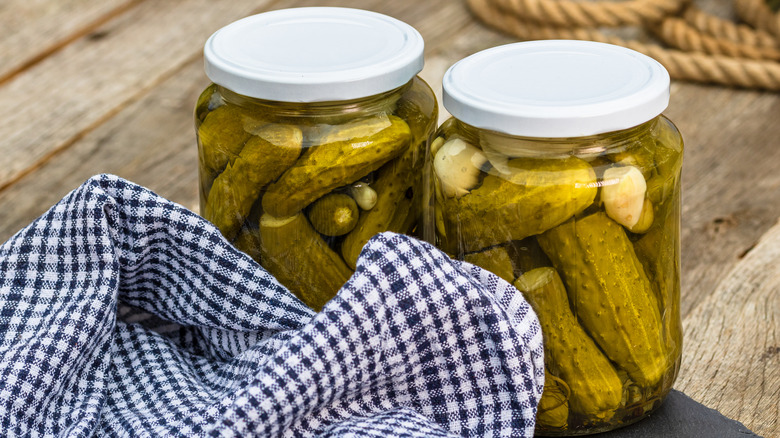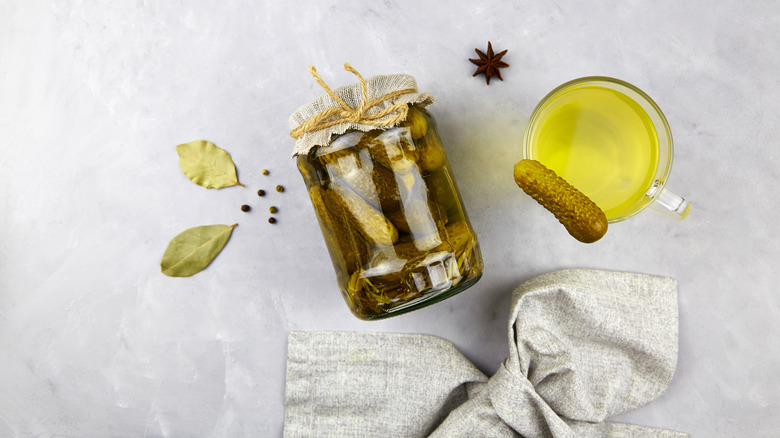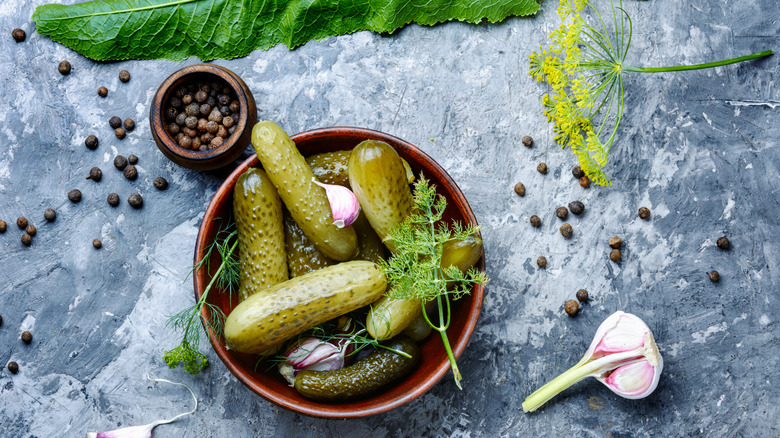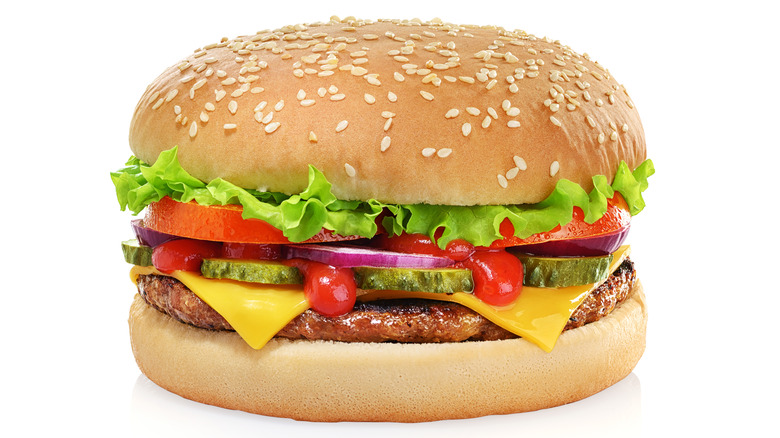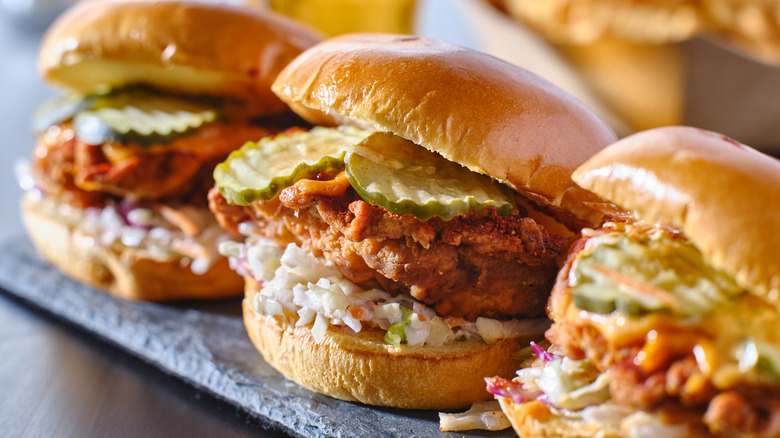Everything You Need To Know About Pickles
Pickles are a staple in many different cultures and regions throughout the world. In fact, they are so popular, the movie "The Little Rascals" has a famous scene where one character sings "I have two pickles, I have two pickles, I have two pickles today, hey, hey." Have you had two pickles today?
The juicy snack got its start more than 4,000 years ago, in 2400 BCE. The ancient Mesopotamians started soaking cucumbers in acidic brine, per The History Channel. Cucumbers don't last super long, so soaking them would help preserve them for longer. Among history's pickle boosters: Cleopatra, who loved pickles and said they were what made her beautiful.
She wasn't the only one. Pickles have been a popular snack among historical figures for thousands of years. Roman emperors Julius Caesar and Tiberius, Queen Elizabeth I of England, George Washington, and Napoleon Bonaparte are just a few famous names of those who were "pickle-lovers," says Pickle Guys. All of that raises the question: What even is a pickle?
What exactly is a pickle?
What many people today think of when they think of a pickle is in fact a cucumber, which can be considered both a fruit and a vegetable. Basically a vegetable, but the U.S. Supreme Court declared them a fruit because of their seeds, per The Food Channel. The best of both worlds! They are placed in a brine, vinegar, or another similar solution that ferments the cucumber. It will soak for a period of time and soon enough, it'll transform itself into a salty, vinegary pickle. Whether you are eating a cucumber or pickle, the journey starts the same way.
Cucumbers come from a cucumber bush or grow on vines. They have to be picked and washed before anything else can be done. They grow in hot temperatures and need a lot of water. The pickling process solution is usually a mix of water, salt, spices, and vinegar (via American Farm Bureau Foundation For Agriculture).
The name "pickle" actually has to do with the way they are made. The word comes from the Dutch pekel or northern German pokel. It means salt or brine, which are both very important in the pickle making process. In fact, you can't make them without the two (via The History Kitchen, posted at PBS).
The taste of pickles
The taste of pickles varies, depending on the pickle variety. The most popular would be dill pickles, which is not to exclude sour pickles, bread pickles, gherkins, and examples from Hungary, Germany, and Poland, per Fruit Stand.
Kosher dill pickles seem to have a balance of sweet, salty, savory, and juicy. That is a lot of taste profiles packed into one crunch. The dill part comes from the spring-like herb flavor that is left after the brining process. The only difference with a sour pickle is just a longer fermenting process. The longer a cucumber sits in brine, the more sour it'll become (via Fruit Stand). The same effect goes for less brine time. If it isn't fermented long enough, it'll still have a cucumber flavor and crunch.
Bread and butter pickles are what you would actually put on your bread — the kinds that get stacked on your favorite burger or go-to sub. They are fermented a bit differently than the others. That process combines vinegar, sugar, onions, and red and green peppers, per Fruit Stand.
Gherkins also known as baby pickles. They're just bumpy, crunchy, smaller pickles. These flavors can change in taste as they are brined in sugar. Another baby pickle, cornichons, get their distinct flavor from tarragon. German, Polish, and Hungarian pickles are all a game of their own. Each type is fermented with different ingredients, such as bread, or perhaps less salt. The pickle options are truly endless.
How to cook with pickles?
Pickles are one of those foods that you don't even have to cook. You can simply crack open a jar and stick your fingers in there to grab however many slices or sticks you desire. The flavor complements many dishes, making them a go-to for salad, burger, and sub toppings.
Tuna salad is one popular dish that often includes a ton of chopped-up pickles. Tuna salad is just tuna, celery, chopped cilantro, pickles (obviously), lemon juice, oil, and pepper. Basically, you mix it all up in a bowl and serve. Simple, quick, and tasty.
You can also fry pickles, which was a favorite of Elvis Presley, says Food Channel. Whether sliced or whole, they can be fried to your liking and dipped into your favorite sauces. Another use of pickles is in the creation of a variation on the classic Bloody Mary cocktail — Delish offers a recipe utilizing pickle juice and cornichons.
You may have even added them to potato salad, pasta salad, and deviled eggs. The sweet, tangy, and sour flavors lend well to so many dishes, it is hard to imagine something they wouldn't taste good in. A common "pregnancy craving" is a peanut butter sandwich with pickles.
Are pickles good for you?
Since they are considered both a fruit and vegetable, you might guess that based on that alone, they have to be at least somewhat good for you, right? And you would be correct. They are a great source of vitamins, potassium, and antioxidants, per Wide Open Eats.
Pickles are stuffed with vitamins C and E, both of which help fight off free radicals, which can cause cancer and heart disease. They boost gut health because of the fermentation process. This helps create good bacteria that'll help the digestive system and immune system.
One dill or kosher dill pickle has just four calories, .8 grams of carbohydrates, and .3 grams of fiber. There is a downside, however, as one pickle contains 283 milligrams of sodium, per Healthline. Consuming pickles indiscriminately can quickly put you over your daily sodium limit. This means having high blood pressure makes pickles a less-than-ideal snack. Limiting your pickle intake is the best way to still fulfill your pickle craving.
